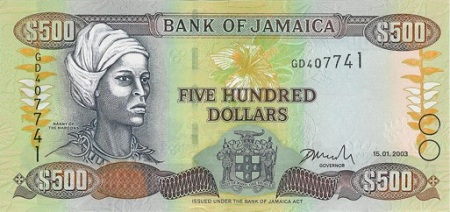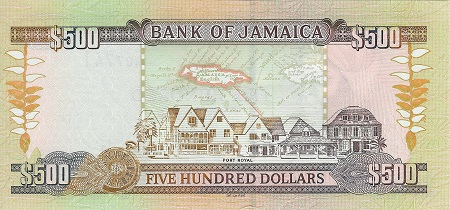JAMAICA
Nanny of the Maroons

Exhibiting the courageous fighting spirit found in military leaders, Nanny of the Maroons established herself in history as Jamaica’s only female national hero. She became known for all time as a symbol of Jamaica’s strength and dogged resolution to maintain independence. She was known also as Granny Nanny by modern Maroons, and the Right Excellent Nanny of the Maroons and was described as a small, wiry woman with piercing eyes. She was also mentioned as wearing a necklace made from the teeth of British soldiers.
African slaves were brought to Jamaica by the Spanish in 1517. The Spanish and their slaves fled into the forested mountains when the British attacked the island. They fought against the British until 1655 when Spain ceded the island to Britain and left. The slaves however, remained in the mountains and continued to fight the British. These people interbred with the indigenous people of Jamaica and became known as the ‘Maroons’.
The British continued to bring in slaves from the Gold Coast of Africa. The Maroons would raid the plantations and they would encourage the new slaves to run away. The woman who was known as Nanny was one of the Ashanti Tribe slaves who would take their advice. The Ashanti women were well respected in their culture and knew the art of war.
When Nanny arrived in Jamaica, there was already a movement among the slaves for freedom. Several rebel towns comprised of escaped slaves were already formed on the island. Maroon rebel towns were reputed to be the best defended of these towns. Soon after her arrival, Nanny was able to escape with her brothers Cudjoe, Accompong, Johnny, Cuffy and Quao.
In the early 18th century Nanny had established herself as a leader of the Maroons. Her brothers were also instrumental in the freedom of Jamaica. Cudjoe was sent to St. James and built a free village called Cudjoe Town. Accompong was sent to St. Elizabeth where a town was also named after him. Nanny and her brother Ouao traveled to Portland where they became leaders of the freed and escaped Africans there. Thus, with the dispersion of Nanny and her brothers, there came to be two sects of Maroons. The Leeward Maroons on the West side and the Windward Maroons on the East side.
In 1720, Nanny controlled Blue Mountain Rebel Town and renamed it Nanny Town. Being Ashanti, Nanny and Ouao modeled the town after an Ashanti Village. They cleared over 600 acres of the forest for cultivation purposes. The food from these farms was traded in the towns for weapons and other supplies. Nanny Town itself was Located on a 900 foot ridge overlooking the Stony River. Nanny placed guards along the single route to Nanny Town and also incorporated Ashanti type communications amongst the Maroons, using drums and horns. The British were unable to decipher these messages which gave the Maroons advantage over the British, eliminating the ability for them to attack without warning.
The Maroon warriors learned how to camouflage themselves to blend in with the lush vegetation of the forests. Nanny is said to have taught them how to stand still and look like the trees of the forest. Then, other Maroons would lure British forces into following them into ambushes. As people who were used to living off the land, the Maroons were able to withstand the elements more than the British soldiers were. The British suffered from their inability to adapt to the rain forest, and many died from tropical illnesses.
Nanny organized raids on British plantations, stealing food, arms, and whatever else they could get. Plantation slaves were freed during these raids and most of them joined the Maroons and helped their numbers grow. She also placed spies in the plantations that would then get word to the Maroons with important military information, helping Nanny keep her edge over the British.
Nanny’s reputation as a holder of supernatural powers and the Maroons fierce fighting abilities gave them the advantage of psychological warfare against the British. She also held a psychological power over her Maroons with oaths of secrecy and bolstering their confidence in themselves and her leadership ability. She also kept the pride and sense of unity among the Maroons alive and well by fostering their customs, tales and musical traditions.
In 1734 Nanny Town was finally captured by the British after bombardment with cannon. Though the British claimed to have killed all of the Maroons in Nanny Town, Nanny and some others escaped and set up a new hide out in the Rio Grande area.
After the capture of Nanny Town, the Maroons became despondent. Their city and crops they had cultivated were destroyed, leaving them with nothing. Nanny evidently prayed to Nyankopon, the creator god of her faith, for several days and nights, and eventually got a vision telling her to never give up the fight for freedom. The vision also instructed her to plant the seeds she had in her pocket. Those seeds were pumpkin seeds, and she dutifully planted them. Soon, the whole hillside was covered with pumpkins and is today known as Pumpkin Hill, located outside of Port Antonio.
Later in 1734, Nanny led her people to the west side of the island to join with the Leeward Maroons. This long march of more than 300 people was known as the “Great Trek”. Their way along this arduous journey was hampered by skirmishes with British forces. Once arrived at St. James, Nanny’s brother Cudjoe refused to unite with Nanny’s Windward Maroons. It seems that Cudjoe had taken a different tact and was seeking peace with the British and didn’t wish to unite with Nanny to make war. Nanny and her Maroons would not agree to this and they began the long, hard trip back to Portland.
In 1737 Nanny took an oath on Pumpkin Hill that she would never let up the fight against the British. In 1739, Cudjoe signed a treaty with the British for peace in return for his allegiance in abating revolts against the British rule, submit to British supervision and to help return run-away slaves. Nanny, though she saw that her people were tired of war and wanted peace, would not agree to these terms. Instead, she entered a truce with the British, to bring some respite to her Windward Maroons.
Her hold over the Maroons was so strong that it was said that she had used magical powers of Obeah, a type of folk magic similar to Voodoo, having both white and black magic associations. One tale is that Nanny kept a large cauldron at the base of the trail leading to Nanny Town. This pot was always boiling, but there was never a fire. As the British would pass by, they were amazed and looked into the large cauldron to examine it. They would breathe in the fumes and become sleepy, falling into the large pot where they would then die from a lack of fresh air.
Another legend often told about Nanny was that immediately after signing the truce with the British, she asked them to shoot her. The puzzled British at first declined. Nanny then demanded that they fire at her, and eventually the British obliged. As the guns were fired, Nanny evidently spun around, and bent down. Then, straightening up and turning again to the British, she walked to the British officer and returned the bullets to him. She said to him: “There is peace’ and then pointed to the sky and said “Only one can kill me”.
After the truce, Nanny and Ouao split, he going to Crawford Town and her moving to a 500 acre plot at a place called Cottawood. Today, Moore Town is now the primary town of the Windward Maroon people.
Though Nanny did not win the freedom that she had so fiercely and bravely fought for, she was an inspiration and role model for those that followed in her footsteps, and she is today a symbol of the valiant effort to pursue independence. It was not until 1962 that Jamaica eventually found freedom that Nanny had helped to bring about. At midnight on the 5th of August, 1962 the British flag was lowered and the Jamaican flag was raised for the very first time.
Nanny died in around 1758 and is buried in Maroon town at a place known as Bump Grave. In 1976 she was honored as a national hero of Jamaica, the only woman to hold this honor.
In 2022 she was again honored by being placed with the Rt. Honourable Samuel Sharpe on the $500 Dollar banknote. This 500 Dollar bill is from Jamaica’s first foray into Polymer banknotes, and incorporates a host of new security features, the most obvious of course being the clear window prominent in all polymer notes issued so far. On the front of this note is Nanny of the Maroons and Samuel Sharpe, both slaves who rebelled against the British and helped to usher in abolition for Jamaican slaves and help the British embark on an anti-slave trade campaign, which would eventually grow to have global implications benefiting all enslaved humans from their bondage.



